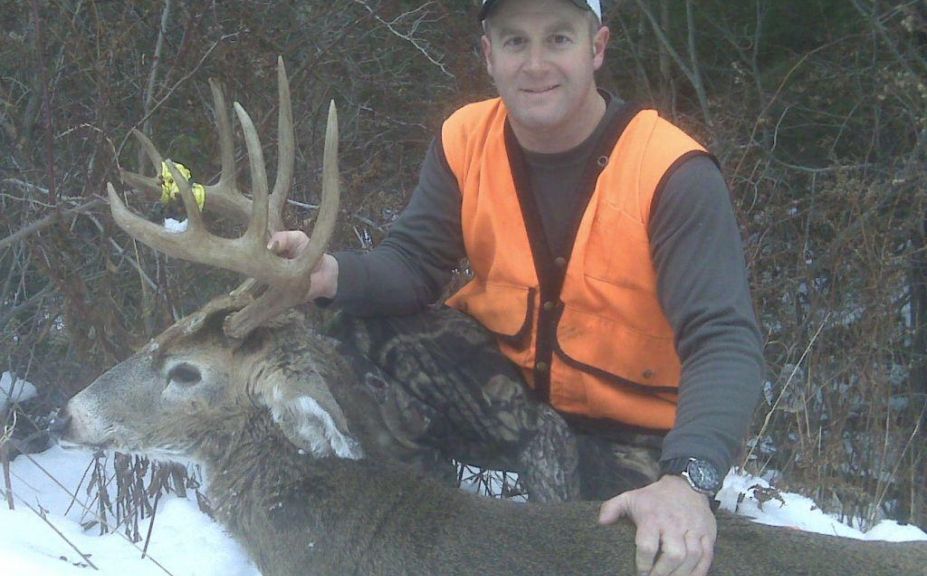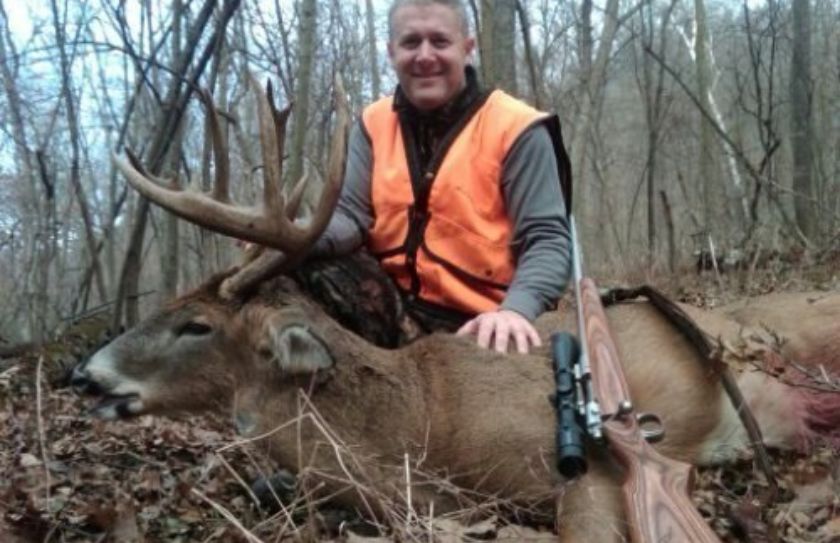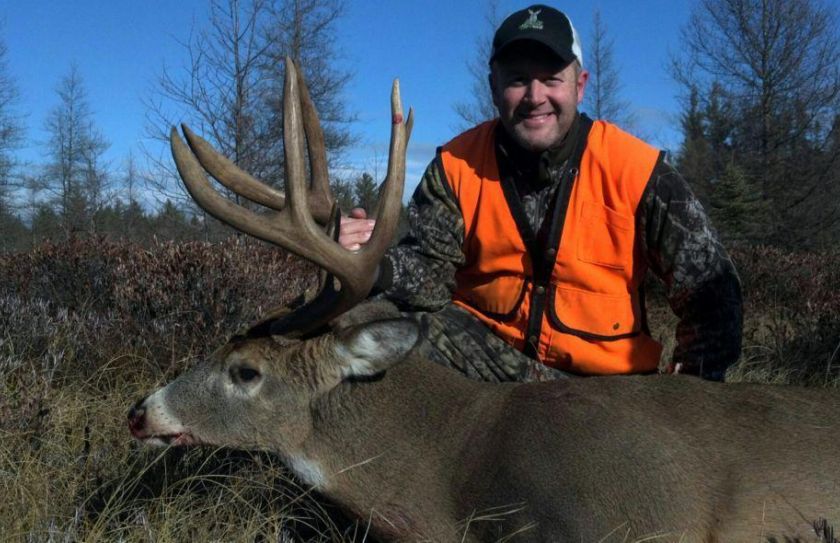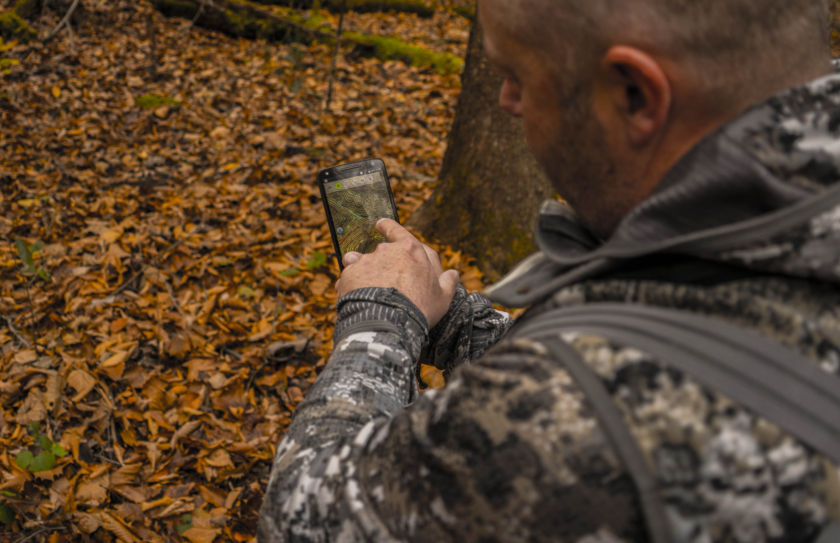In 2009, Jake, my 7 year old son went on his trip of a lifetime! We sat one day in the rolling hardwoods of PAs public land rifle-season opener and from start to finish he had that wonderful perma-grin that every parent recognizes. Jake was on a high the entire trip, from weeks before starting the 13 hour drive from MIs Upper Peninsula, to slowly drinking his sacred energy drink throughout the drive back. And NO, do you think I would always allow my 8 year old son to drink an energy drink? Instead, when thinking of what surprise he would love to have in the blind with him that day the energy drink came to mind. I thought he would gulp in right down but nope, not Jake, who is always full of surprises. Jake thought he was getting a new facemask, gloves, or something else hunting related. However, when I pulled out that energy drink he proceeded, to my surprise, to place it gently in the corner of our make-shift nest of a blind as if it were a shiny trophy of one of lifes major accomplishments. His big brown eyes stared at that can much of the day and when he asked if he could save it to drink on the way home, I simply said, Yes. I wasnt too torn when he spilled the can either!
Jake and I had a 45 minute hike into our spot we had picked out the day before. It rained most of the day and the temperatures were not much higher than freezing. We didnt fire a shot, and we only saw 3 deer, but we were both fully of anticipation. Jake sat 10 hours that day and although actually shooting a deer would have been just the icing on the cake, in my experience the odds were heavily in our favor to harvest a decent buck. Jake had some idea, but we were playing out a pattern that had worked the majority of the time during my 16 seasons of hunting within the area. In fact, although vastly different in habitat and terrain, that same pattern has worked a dozen seasons or more on public land in MIs Upper Peninsula and it is the same pattern that has worked for me on both public and private land throughout the last 23 years of my hunting experiences.
Public land? Private land? It really doesnt matter to me, its all the same concept and like I was hoping a little would rub off on Jake during last years trip of a lifetime, Im hoping after reading this article there might be some tips that you can apply to your future public land mature buck hunts, as well as in private land too!

The Pattern
Public land can sometimes be a continuous and vast almost boredom of similar habitat and topographical features. State land, to an even further extend Federal Forestry lands simply dont typically have the reputation for the micro-management of wildlife species, instead centering largely on future timber production and re-forestation. And although that thought could be a great discussion in itself, where do you start your scouting efforts within a tract of land that seemingly is all the same? To me, this is where the pattern becomes easy BECAUSE of what makes it seem so difficult in the first place. The first portion of the pattern I like to employ is, if it looks all the same, dont hunt there! Imagine a 30 square mile area. My goal is to take that 30 square miles and narrow it down to less than 100 acres to actually scout. In PAs rolling hardwoods that means keying in on the very few hemlock bottoms that dot the hidden hollows and draws. On an ariel photo these dots of conifer stick out like a sore thumb and by the time you add in the factors of getting away from all roads and trails by at least a mile, using a cut-bank stream for a quiet approach, and sitting downwind of a secluded bench with a higher than typical concentration of rubbing activity somewhere around the upper edge of that hemlock bottomthe pattern is starting to take shape!
In MIs Upper Peninsula that may mean looking at a similar sized area of open grassy marshes mixed with slight conifer and hardwood ridges, ignoring the marshes, the open hardwoods and pure stands of conifer, only to focus on where they all come together in layers to produce a hub of deer activity.
In my experience where those layers of habitat change all come together are where you should be focusing your hunting efforts and when you take other hunters out of the equation the best you can, and only focus on the areas with the highest concentration of those layers, your success rate should be very high.
Working the Pattern
Those layers of habitat change are critical for taking large areas of continuous similar habitat and narrowing it down to very small areas of concentrated deer movement. On private land, you have the ability to CREATE that next great place to hunt, but on public land you are left to simply have a good eye and a little experience on your side when searching for your next great place to hunt. Either way though, when you narrow down your search to that hub of layered habitat change, what do you do? This is where I find your efforts are critical. There are two things you have to be thinking about when attempting to hunt your new-found honey-hole; Preserve and Protect. Because what I have found is that while finding a great spot might seem easy with a little experience, ruining that same great spot is actually so much easier!
Your APPROACH, has to be perfect. This is where many great hunts are destroyed on both public and private lands before they even begin. If you are entering during the morning hours, for example, where are the deer feeding? Was there a full moon well into the early hours of darkness so the deer are already back into their bedding areas? What about high winds, or even calm conditions that may cause the deer to be in their beds earlyor still in their food sources. Is it the early season and the mature bucks are tucked into their beds? Or is it during the pre-rut and the big boys are coming back a little late after night of hitting the field edges. And then there are a multitude of factors for an afternoon approach as well, including: Is your scent blowing out a bedding area on the way in, are you going to spook any bedded insubordinate does or young bucks scattered to the exterior of bedding areas, and are great food sources a problem in that no matter what time of the afternoon you approach the deer are already eating!
Your USE, has to be an educated guess. Rarely can you get away with sitting right in the middle of your honey-hole. Instead, setting up on the downwind side is extremely important, unless of course that is where the deer are actually approaching from. Having at least two stand positions is critical, and the ability to be mobile with the use of a climbing stand isnt that bad either. Are you going to leave a scent trail through the spot? Are deer going to cross your scent on the way in? And is the wind going to shift during your sit whether it be a change in weather patterns or thermal movements. Are there any natural obstructions you can take advantage of to pinpoint deer movements within the hotspot? or to possibly act as a downwind blocker to keep your scent contained in a deer-free zone?
Your DEPARTURE, saves the spot for future use. Consider all the factors of access, as well as, Do you want to hunt this spot again? We take great care in getting to our favorite stand, the wind direction was great, we entered and then exited with zero careless sounds, our departure was direct without spooking gamebut the stand is ruined! Why? Because 3 hours after you left that super-shy giant of the woods you were after walked by your stand, smelled where you hands had touched the bow rope still hanging, smelled where your hands had touched the last step, smelled where your hair had carelessly grazed the nearby licking branch, and who knows what he thought about the incredible saturation of scent where you went down to one knee while combing through your pack for a flashlight. Could that happen 4 hours later? 5, 6 hours later? Ive personally witnessed a wary doe react negatively to a single clump of waist high weeds that managed to get a good dose of hand-scent over 3 hours earlier, or a couple of mature bucks cruising a field edge take off on a dead sprint after crossing a bird-hunters scent from a few hours earlier. I think that negative aspect of departure happens as much as any other spoiling factor combined and if you are hunting private land the cumulative effects can be devastating to both your hunting and management efforts. Come to think of it, thats probably why 15/17 of my oldest buck kills have taken place the first time using the stand for the yearmaybe I need to listen to my own advice!
Preserve and Protect when using your new found hotspot of layered habitat features and the pattern of solving the public land puzzle should be a great tool for your future hunting experiences.
Conclusion
Jake will be back with me in PA this year, only this time as an 8 year old with a rifle he can shoot himself. Im expecting to be a part of not only his next trip of a lifetime, but to take part yet again in the pattern of hunting that has helped me on every land Ive hunted or managed my entire career. And once again our expectations will be extremely high, Jake will probably huff and puff on the way into the stand in the dark as his father is moving a little too fast, and actually shooting a deer will only be the icing on the cake. For myself, my experience will start to be complete when Jake shows that he is beginning to understand the pattern that I have enjoyed for so many years. However, my experience will be fully complete when and my son turns to me randomly during the middle of the day like last year, looks over at me, smiles, and simply says, I love you daddy. That was by far my single most favorite hunting experience to date!


